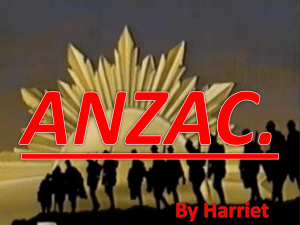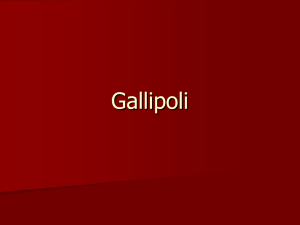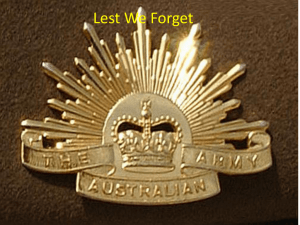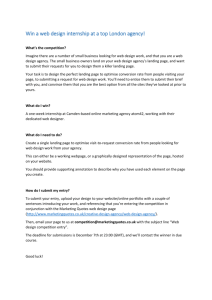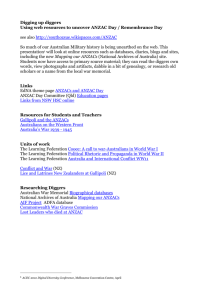Premier`s History Teacher Gallipoli Scholarship
advertisement
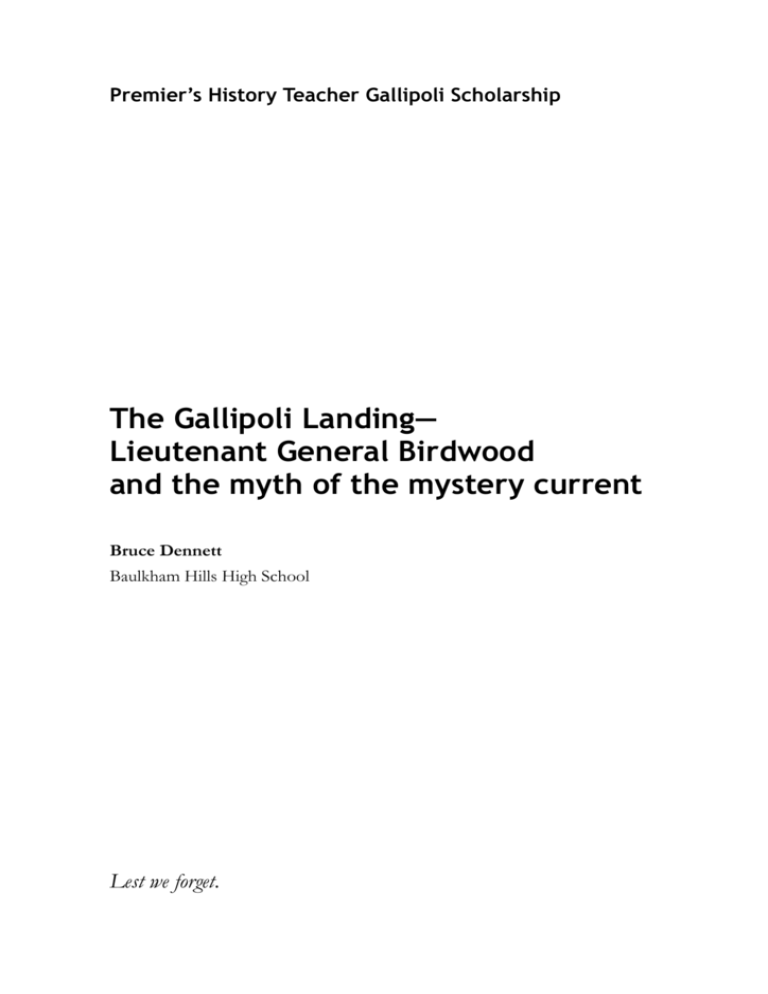
Premier’s History Teacher Gallipoli Scholarship The Gallipoli Landing— Lieutenant General Birdwood and the myth of the mystery current Bruce Dennett Baulkham Hills High School Lest we forget. As per my scholarship proposal, I spent my time overseas in the archives of the Imperial War Museum, London, the Liddle Hart Collection at Kings College Library also in London, the National Archives at Kew, the National Maritime Museum at Greenwich and the Liddle Collection at the University of Leeds. My time at Leeds was very important. I was the first, and to date the only, Australian to use the Metcalf Papers held there. The Metcalf Papers are critical to any debate about the location of the Anzac landing on the 25 April 1915. I also conducted interviews in Canberra with the British military historian Denis Winter, author of April 25, and with Dr Peter Stanley, Chief Historian of the Australian War Memorial. The archives of the Australian War Memorial were also important and I spent several days before and after my time in the United Kingdom researching the Birdwood and Bean Collections. As the following extract from my full report indicates, I was able to prove, finally and conclusively, that there was no current on the morning of the landing sufficient to influence the location of the landing. Dr Peter Stanley commented that following the publication of the full version of my report no one will be able to write about the first day at Gallipoli without acknowledging my work. Since my return from the United Kingdom, I have presented my research findings at two conferences, the State Conference of the NSW History Teacher’s Association and the Australian History Teachers’ Conference in Adelaide. Following the normal academic process of peer review, the Australian War Memorial will publish the full, 7000 word version of my report in the Journal of the Australian War Memorial. The AWM has also commissioned me to write two further articles, one based on my interview with Denis Winter and the other on the Royal Navy midshipmen involved in the Gallipoli Landing, for their popular magazine Wartime. The following is an abridged version of my report summarises my key research findings. The thesis This article will establish conclusively that there was no current on the morning of 25 April 1915 capable of influencing the Gallipoli landing. Once that thesis is established it becomes necessary to explore some of the possible scenarios that might account for the invention and the durability of such a story. It is not easy to ascertain the origin of the earliest reference to the existence of a coastal current off the Gallipoli Peninsula on the morning of 25 April 1915. It was nevertheless a convenient story for the commander of the Australian and New Zealand Army Corps, Lieutenant General Sir William Birdwood. Following the landing when it became clear that the Anzacs were concentrated in difficult country, disorganised and hard pressed by Turkish defenders, Birdwood reluctantly began to agitate for a withdrawal and reembarkation. He was overruled by the commander of the Mediterranean Expeditionary Force General Sir Ian Hamilton, acting in part on advice from Rear Admiral Cecil Thursby, in command of the 2nd Royal Navy Squadron supporting the landing. It was from this time that Birdwood began referring to the twist of fate, in the form of an uncharted current that had taken the Anzacs too far north. The story became part of the official history of the campaign,1 becoming a ‘fact’ of history and an integral part of the Gallipoli legend. However, we now have overwhelming evidence to refute the claim that any current existed significant enough to have contributed to the Anzacs landing where they did. The work undertaken by Denis Winter2 and Tom Frame,3 when combined with my own recent review of the documents held in the United Kingdom and at the Australian War Memorial, is more than sufficient to reject what appears to be Birdwood’s self-serving version of events. Tom Frame maintains that the first references to a current did not come from the navy but from an assertion by Birdwood.4 ‘Certainly there is no mention of a current having hampered the landings among naval officers who might have given this suggestion some credence even after it was first proposed by Birdwood.’5 Why did Birdwood propagate the tale of a mystery current? Let us take the time to speculate. If there was no current, what are the possible explanations for Birdwood’s assertion? Was it perhaps the first thought that came into his head? Maybe Birdwood couldn’t imagine any other explanation for his covering force landing where it did. Was it a desire to protect Rear Admiral Thursby and the reputation of the Royal Navy following a failure of navigation? Or was it Birdwood’s intention to protect his own reputation? Birdwood had been granted significant discretion in planning the landing. He may therefore have felt the need to deflect possible criticism when it became clear that the operation had started badly. Birdwood was not the kind of man to express his opinions rashly. Therefore, the responsibility for the location of the Anzac landing on the 25th rests with errors made by the Royal Navy and/or with a series of decisions made by Birdwood.6 In other words, when it became clear to Birdwood that he had miscalculated, he needed a story (and a current) to explain away the predicament on the beach and to strengthen his case for re-embarkation. Looking for answers—Birdwood and Thursby It is fair to say that the commanders, particularly Birdwood, displayed both skill and energy in defence of their reputations. By contrast, in planning, staff work, and supervision of the actual operation, they appear to have been less assiduous. But Birdwood and Thursby were creatures of their time, and as Denis Winter pointed out, ‘an appreciation of the need for absolute precision in battle planning only came in 1917.’7 The lack of quality staff work for the Anzac landing and the Gallipoli operation as a whole was reflected in Major General Walter Braithwaite’s testimony before the Dardanelles Commission on 25 January 1917. Braithwaite and Hamilton only went out to Gallipoli on 13 March 1915. When asked at the Commission whether Hamilton had received much in the way of useful information, Braithwaite replied that ‘there was nothing of which turned out to be of real value.’ 8 A lack of adequate planning and coordination clearly contributed to misunderstanding and confusion once the operation began. As we look for answers it is important after a review of decades of research and comment to reject absolutely any idea that a current played a part in the location of the landing. Unfortunately, this myth is so deeply ingrained in the public consciousness that it has been difficult to shift. As recently as 2001 Les Carlyon tempered his rejection of the current with the words, ‘We can probably forget about the current.’ 9 We need to be more emphatic: there is no probably about it, unless you accept the miraculous. The current, if it is to be believed, influenced the movement of some of the tows but not others. Metcalf and the tows near him, excluding tow one, veered north, while Dix at the northern end of the line held course. Such a current had to be utterly random, capricious, and idiosyncratic, choosing to influence some, but not all of the tows. This was not an element of nature; it was a product of human imagination. Tom Frame offered a powerful argument in 2000, when he consulted the Turkish Navy and their oceanography specialists. They revealed that the prevailing current, if any, operating off Anzac Cove was 0.25 to 0.5 knots to the northeast and that it was ‘certainly not of sufficient strength to have resulted in the Anzacs being landed one mile or more to the north of their intended location’.10 This should be enough, but there is more. Following a conversation with Denis Winter before leaving for the United Kingdom to undertake my own research, he prompted me to look closely at the records of the Royal Navy’s Hydrography Department. It turned out that Winter had already seen and cited a key document without pursuing its implications. The document in question is part of the Bush Papers at the Imperial War Museum; it is a report from a Royal Navy warship, HMS Humber, that served off the Gallipoli coast between Gaba Tepe and Niebruniessi Point, immediately to the south and north of Anzac Cove, for six months between July and December 1915. The report was sent by the navigator of the Humber’s Lieutenant, HEB Haselfoot, and co-signed by Commander AL Snagge, the Humber’s commanding officer. It states that HMS Humber had, ‘considerable facility for observing the direction of the currents’. This facility was the result of the length of time spent off that stretch of coast and by reference to ‘the numerous submarine indicator nets 500 yds. in length and moored at one end.’ The report concluded that the normal set of the current off Anzac Cove ‘is to the NW about 1½ knots’, but that it could be influenced by ‘the direction and force of the wind’.11 It should be remembered that primary source accounts from the morning of the landing are unanimous that there was no wind and that the sea was calm. In fact, if winds and storms did play a part, it had to be from the residual effect of the storm on 21 April that lasted for 24 hours and caused the postponement of the landing planned for 23 April. According to Orlo Williams, a captain attached to Hamilton’s staff, the gale blew out of the northeast.12 The implications are that according to the Humber’s report, ‘A strong NE wind will cause a set to the SW of about 2 knots.’13 In other words, the current off Anzac Cove on the morning of 25 April at most would have been 1½ knots to the north,14 but given the strength of the gale that blew for 24 hours and caused a delay in operations, any current was likely to have been negligible or been still running slightly to the southwest. If this isn’t enough, Peter Liddle conducted an interview in 1974 with Anzac H Bachtold, who had been part of the First Field Company of Engineers. On the afternoon of the 25th Bachtold was part of an operation to deliver three, 100-foot-long pontoons or floating jetties to the beach. With a small steam pinnace and rowboats, the engineers had to manoeuvre the jetties into position. Bachtold commented that the Royal Navy beach master at Anzac Cove told them to ‘go further south and off we pushed and went down south and then just as we were getting ready to push in to the shore he came along and said go further north, so off we went.’15 Manoeuvring the jetties was a difficult process, but at no stage did Bachtold mention a current. Clearly such an operation would have been complicated had a current of the kind invented by Birdwood existed. What of Birdwood? What did he say at the Dardanelles Commission? Birdwood thought long and hard about the commission. Between January 1916 and December 1918 Birdwood and Hamilton conducted a lengthy and familiar correspondence. Birdwood addressed his letters to ‘My dear General Johnny’, while Hamilton was no less personal opening his letters with, ‘Dear Birdie’. The correspondence reflects a desire to get their stores straight for the commission. On 27 November 1916 Hamilton wrote to Birdwood, ‘I am sending you to-day my own reply to Dardanelles Commission. It should help you in framing yours.’16 Then on 31 January 1917 Birdwood wrote to Hamilton, ‘I much hope it may be possible to see you before I give evidence, and shall look forward to a talk with you about it.’17 The letters also reflect a desire to shift the focus of the commission away from them and blame the failure of the campaign on supply and shortages of ammunition. In evidence, on 6 March 1917 Birdwood repeated his preoccupation with the threat posed by the Turkish artillery at Gaba Tepe. The key moment, however, came when Birdwood was asked did his force land ‘exactly at the spot you intended to land?’ He replied ‘not exactly’, and went on to explain, referring to a map, that he had intended to come ashore ‘opposite the capital “K” in Kurija Dere’.18 For clarity Birdwood used the same words again a little later in his statement. This is interesting. Looking at the maps, including the chart used by HMS Chelmer, one of the destroyers involved in the landing,19 and others it is clear that if Birdwood intended to land opposite Kurija Dere then his force should have come ashore where he planned, not a mile and a half north as he claimed. If the ‘K’ in Kurija Dere marked the point where tow one was meant to come ashore and allowing for the planned separation of 150 yards between the twelve tows, the bulk of the Anzac force would be spread across almost a mile and therefore right across Anzac Cove. If Birdwood meant that the ‘K’ marked the centre of the line of tows, then at least half of the initial landing would have found itself in Anzac Cove. The only way for Birdwood’s comment to have made sense would have been had he thought that tow twelve was meant to come ashore opposite Kurija Dere; but then why was tow one the guide? The place where the Anzacs came ashore and the place where Birdwood indicated to the Dardanelles Commission that he intended to land are one and the same. Birdwood testified that he had warned the navy that if his troops were heavily shelled from Gaba Tepe after coming ashore that he would move north.20 Did Birdwood simply jump the gun and incline to the north sooner rather than later? Aside from the perennially valid explanation, attributing all errors and confusion to ‘the fog of war’, we are left with no current and hence no excuse. The Anzac landing was due either to design arising from Birdwood’s well attested fears of getting too close to Gaba Tepe or to mismanagement. Faulty navigation cannot be ruled out and we must also acknowledge that Birdwood and Thursby certainly didn’t micro-manage the landing. The Anzacs came ashore in accordance with their orders between Gaba Tepe and Fisherman’s Hut, almost exactly half way between the two, in fact. Remember, precision wasn’t necessarily thought to be critical; the main landing was, after all, meant to take place at Helles. The lack of precision and having landed at Anzac Cove only became problems for Birdwood after the landing. From that time, Lieutenant General Sir William Birdwood’s reputation and career required an excuse and a ‘mystery current’. Endnotes 1. CEW Bean, The Story of ANZAC, Angus & Robertson, Sydney, 1939, preface to the 9th edition, p. xi. 2. Denis Winter, 25 April 1915: The Inevitable Tragedy, University of Queensland Press, St Lucia, 1994. 3. Tom Frame, The Shores of Gallipoli: Naval Aspects of the Anzac Campaign, Hale & Iremonger, Alexandria, 2000. 4. Ibid, p. 195. 5. Ibid, p. 196. 6. Denis Winter, 25 April 1915: The Inevitable Tragedy, op.cit., p. 149. 7. Denis Winter, 25 April 1915: The Inevitable Tragedy, op.cit., p. 98. 8. Transcript from the Dardanelles Commission in the Hamilton Papers, 8/2/10-11 (Braithwaite), Liddle Hart Collection, Kings College, London. 9. Les Carlyon, Gallipoli, Macmillan, Sydney, 2001, p. 142. 10. Tom Frame, The Shores of Gallipoli: Naval Aspects of the Anzac Campaign, op.cit., p.200. 11. Report from HMS Humber found in the Bush Papers Bush Papers, 75/65/2 Anzac Day Folder, Imperial War Museum. 12. Dr Orlo Williams, Private Papers 69/78/1, War Diary, vol. 1, Dardanelles Imperial War Museum. 13. Report from HMS Humber found in the Bush Papers Bush Papers, 75/65/2 Anzac Day Folder, Imperial War Museum. 14. At 1½ knots, still not strong enough to account for a northerly movement of up to a mile or a mile and a half. 15. ANZAC (Aust) Bachtold, H, Tape 244, Interview conducted by Liddle May 1974, Liddle Collection, Leeds University. 16. Hamilton Papers, 8/1/51-57 (Birdwood), Liddle Hart Collection, Kings College. 17. Ibid. 18. Birdwood’s Evidence before the Dardanelles Commission in the Hamilton Papers, 8/2/7, Liddle Hart Collection, Kings College. 19. Papers of Rear-Admiral HT England, in command of the destroyer HMS Chelmer at Anzac 76/43/1. 20. Birdwood’s Evidence before the Dardanelles Commission in the Hamilton Papers, 8/2/7, Liddle Hart Collection, Kings College.
